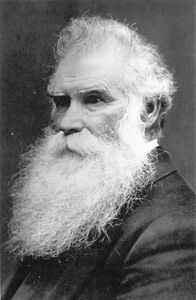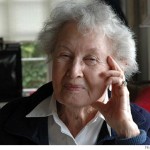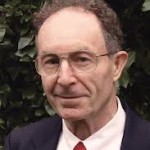From the early days of Latter Day Saint history, education was always an important part of the LDS scenario. The 1857 edition of a Welch periodical is proof of this assertion. As religious traditions develop a need to internally examine their teaching often arises. This is certainly true in the LDS experience. Among the first of many academics to come was Orson Pratt who brought a scientific approach to Latter Day Saint theology. As need to systematize arose in LDS thinking, B. H. Roberts responded to this by challenging the way the Book of Mormon was being promoted by the churches’ general authorities with his book Defense of the Saints and Faith published in 1893. By 1915, Dr. James E. Talmedge wrote his classic work Jesus the Christ which was influenced by studies at Edinburgh and commentaries by Keil and Delitzsch.
There was obviously a great need for LDS scholars to advance Mormon apologetics. Hugh Nibley, a graduate of Berkley in 1938, answered the call when he accepted a BYU post after serving in military intelligence in World War II. He was offered a position at the University of Chicago but decided to follow the dictates of his faith. His contributions to LDS scholarship over the next 60 years has yet to be completely realized. Nibley’s writings extend from the Egyptian enthronements to the background of the Old Testatment text and comparisons to the Book of Mormon literature.
Later, Why the Kings James Version a treatise on early textual criticism by J. Reuben Clark, Jr was published in 1956 regarding texus receptus, the basis of the King James version. During this period, Sidney B. Sperry began to be accepted by non-LDS academics as an expert in Isaiah as compared to the readings from the Hebrew text and the Septuagint.
The first LDS scholar to achieve academic fame outside the tradition was Dr. Sidney Sperry as well as Hugh Nibley with his work on baptism of the dead published in Catholic Biblical Quarterly. In 1966, W. Cleon Skousen, a former police chief of Salt Lake City, began to have meetings with other Christians at the University of Texas and patriot groups whereby he established The Freeman Institute. His book The Naked Capitalist would become a best seller in the 1960’s. Fantastic Victory –Israel’s Rendezvous with Destiny a report on The Six Day War which he published in 1967 would also be very popular. His spine tingling lectures given around the world in the years to follow would educate many about the current academic opinions held in LDS theology. Skousen’s contributions to Old Testament studies include Isaiah, the Prophet Who Speaks to Modern Times and The Third Thousand Years series which are evidence of this BYU professor’s vast understanding of many theological subjects. Today, his son, Royal Skousen, carries the torch with his published works in linguistics.
In the decades to follow, a complete menu of scholars in various academic fields would emerge into the limelight. Among these were scripture scholars such as Victor and Daniel Ludlow. Victor’s work in his 1982 publication Isaiah Prophet, Seer and Poet was a monumental step forward in Isaiah scholarship. Another significant voice who should never be neglected is Truman Madsen whose impact in the areas of philosophy and Old Testament scholarship cannot be overemphasized.
As the church’s scholarship began to broaden again, numerous voices appeared. By the 1970’s with the introduction of F.A.R.M.S, now The Maxwell Institute, LDS scholars collaborated in major ways with world renowned academics. Among these were James H. Charlesworth, David Noel Freedman, W. D. Davies, Abraham Kaplan, John and Jane Dillenberger and Ernst W. Benz who produced study papers on Mormonism delivered on March 10 and 11, 1978 at the Religions Studies Center Symposium in Provo, Utah. Truman Madsen provided a stimulating introductory essay entitled “Mormonism as Historical” showing that there are historical precedents for the topics that were presented at this symposium.
Through the decades, many position papers were presented at BYU through a series entitled “Symposium in Honor of . . . Sydney B. Sperry”, “Truman Madsen” and “Richard Lloyd Anderson”. These position papers were often edited for publication by Stephen D. Ricks, Donald W. Perry, Daniel C. Peterson and Andrew H. Hedges. During this time, Stephen D. Ricks became the first of many LDS scholars to join the International Dead Sea Scrolls Committee.
Also in this period, a growing number of LDS scripture scholars began to write commentaries about the biblical text. One of the first was Bruce R. McConkie with his three volume work entitled Doctrinal New Testament Commentary which provided doctrinal background for LDS theological positions. Other multi-volume commentaries were also undertaken such as the series Studies in Scripture. The New Testament studies series began in 1985 and was completed in the summer of 1987. The Old Testament studies were completed in 1993. Some of the contributors were Kent P. Jackson, M. Kathleen Thomas, Kay Edwards, S. Kent Brown, Richard Lloyd Anderson, Robert Millet, Richard D. Draper, Andrew C. Skinner, Monte S. Nyman, David Ralph Seely, Joann H. Seely and Robert J. Matthews. New Testament scholarship led by D. Kelly Ogden and Andrew C. Skinner would produce verse by verse commentaries which would cover the entire New Testament while scholars such as Richard Neitzel Holzapfel and Thomas A. Wayment would publish a three volume set The Life and Teachings of Jesus Christ.
At this juncture, evangelical scholars began to notice the Mormon Church’s emphasis on biblical scholarship and accused BYU professors of cross pollinating Joseph Smith’s writings with biblical literature. However, when one reads Avaraham Gileadi’s The Literary Message of Isaiah, only two LDS canonical scriptures are cited. Very few Mormon sources are quoted in the work Masada and the World of the New Testament edited by John F. Hall and John W. Welch and published in 1997. No LDS sources are used for the book Toward Understanding the New Testament by Obert C. Tanner, Lewis M. Rogers and Sterling M. McMurrin published by the University of Utah in 1990.
During the 1990’s, Mormon scholars began to publish widely in world renowned academic reference materials. Some of these include the Anchor Bible Dictionary, The Interpreter’s Dictionary of the Bible, Oxford Companion to the Bible, Oxford Encyclopedia of Archeology in the Near East, and essays in the Festschriften. Academic journals are as follows: “SBL Dissertation Series”, “The Harvard Semitic Monographs”, “Studia Pohl”, “Discoveries in the Judean Desert”, “Harvard Theological Review”, “The Jewish Quarterly Review” and “The International Journal for the Philosophy of Religion”. Until these publications were read by academicians, the growing number of LDS scholarly publications had gone almost unnoticed by the world at large.
Today, the academic community benefits from the hundreds of scholars from the LDS tradition are department chairs and professors in some of the world’s leading universities. A new generation is rising to give modern explanations to historical LDS positions as they develop this evolving religious tradition.
This writer’s hope is that we can continue to build bridges that would bring us together in common causes to benefit all the spiritual and academic communities concerned.








It’s a delight to learn more about my own faith’s scholarship history from a scholar of another faith! Thank you for writing here. I’m enjoying your posts.
I noticed two corrections needed in the post – The spelling of Talmage. And Skousen’s book popular in the 1960s was The Naked Communist. The Naked Capitalist was published later I believe.
Well, not every stroke of the pen is inspired! I’ll check on that. Thank you for your interest.
Nice article! This is one of the best summaries of LDS scholars that I have come across yet.
I was wondering if Dr. Roberts has an opinion on the lack of theological tradition amongst the General Authorities of the church, with most of the best writing and thinking coming from academics and lay members, who don’t ever find their way into the leadership of the church?
It would be great to hear Dr. Roberts weigh in next on Mormon theology within the broader context of Christian theology, and see where he finds overlaps and differences from his perspective. (But beggars can’t be choosers.)
Dear Troy,
Did you see my earlier post on the similarities between LDS practice and nominal Christianity? Some of these likenesses listed are very well known. It would be a pleasure to write a treatise about the differences and the many similarities between LDS and general Christianity from a scholarly viewpoint. With all my heart, I wish we would wake up from the family feud and realize we are on the same team.
In all faith traditions, there is a huge gap from the way academicians think and the more experiential practitioners advance the faith. Unfortunately, experience alone seems to rule the day rather than a combination of spiritual experiences and critical thinking that enlightens the soul.
As you know, leaders often claim a unique calling which by passes any critical assessment and the authority in their eyes comes from truth claims which are contingent upon what they teach. This is true, unfortunately, in all religious traditions. We are well passed in history the Golden Age of biblical exposition which existed from the 1870’s into the 1930’s. Now, we are into dogma blended with fluffy and light spirituality.
Excellent goods from you, man. I’ve understand your stuff previous to and you’re just too fantastic.
I really like what you’ve acquired here, really like what
you are saying and the way in which you say it.
You make it entertaining and you still care for to keep it wise.
I can not wait to read far more from you. This is actually a tremendous
web site.